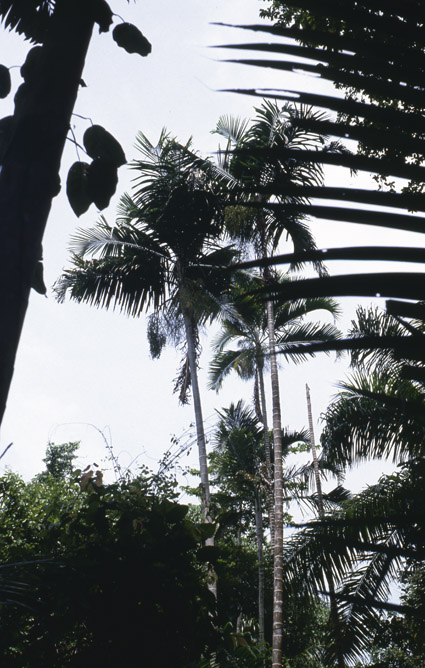- Acanthophoenix
- Acrocomia
- Actinokentia
- Actinorhytis
- Adonidia
- Aiphanes
- Allagoptera
- Ammandra
- Aphandra
- Archontophoenix
- Areca
- Arenga
- Asterogyne
- Astrocaryum
- Attalea
- Bactris
- Balaka
- Barcella
- Basselinia
- Beccariophoenix
- Bismarckia
- Borassodendron
- Borassus
- Brassiophoenix
- Burretiokentia
- Butia
- Calamus
- Calyptrocalyx
- Calyptrogyne
- Calyptronoma
- Carpentaria
- Carpoxylon
- Caryota
- Ceratolobus
- Ceroxylon
- Chamaedorea
- Chamaerops
- Chambeyronia
- Chelyocarpus
- Chuniophoenix
- Clinosperma
- Coccothrinax
- Cocos
- Corypha
- Cryosophila
- Cyphokentia
- Cyphophoenix
- Cyphosperma
- Daemonorops
- Deckenia
- Desmoncus
- Dictyocaryum
- Drymophloeus
- Elaeis
- Eleiodoxa
- Eremospatha
- Eugeissona
- Euterpe
- Gaussia
- Geonoma
- Guihaia
- Hedyscepe
- Hemithrinax
- Howea
- Hyophorbe
- Hyospathe
- Hyphaene
- Iriartea
- Iriartella
- Itaya
- Jailoloa
- Johannesteijsmannia
- Juania
- Jubaea
- Jubaeopsis
- Kentiopsis
- Kerriodoxa
- Korthalsia
- Laccospadix
- Laccosperma
- Lanonia
- Latania
- Lemurophoenix
- Leopoldinia
- Lepidocaryum
- Lepidorrhachis
- Leucothrinax
- Licuala
- Linospadix
- Livistona
- Lodoicea
- Lytocaryum
- Manicaria
- Manjekia
- Marojejya
- Masoala
- Mauritia
- Mauritiella
- Maxburretia
- Medemia
- Metroxylon
- Myrialepis
- Nannorrhops
- Nenga
- Neonicholsonia
- Neoveitchia
- Nephrosperma
- Normanbya
- Nypa
- Oenocarpus
- Oncocalamus
- Oncosperma
- Orania
- Oraniopsis
- Parajubaea
- Pelagodoxa
- Phoenicophorium
- Phoenix
- Pholidocarpus
- Pholidostachys
- Physokentia
- Phytelephas
- Pigafetta
- Pinanga
- Plectocomia
- Plectocomiopsis
- Podococcus
- Pogonotium
- Ponapea
- Prestoea
- Pseudophoenix
- Ptychococcus
- Ptychosperma
- Raphia
- Ravenea
- Reinhardtia
- Retispatha
- Rhapidophyllum
- Rhapis
- Rhopalostylis
- Roscheria
- Roystonea
- Sabal
- Sabinaria
- Salacca
- Saribus
- Satakentia
- Satranala
- Schippia
- Sclerosperma
- Socratea
- Solfia
- Sommieria
- Syagrus
- Synechanthus
- Tahina
- Tectiphiala
- Thrinax
- Trachycarpus
- Trithrinax
- Veitchia
- Verschaffeltia
- Voanioala
- Wallaceodoxa
- Wallichia
- Welfia
- Wendlandiella
- Wettinia
- Wodyetia
- Zombia
- x Jubautia splendens
- ?? Acoelorrhaphe
- ?? Bentinckia
- ?? Brahea
- ?? Clinostigma
- ?? Colpothrinax
- ?? Copernicia
- ?? Cyrtostachys
- ?? Dictyosperma
- ?? Dransfieldia
- ?? Heterospathe
- ?? Hydriastele
- ?? Iguanura
- ?? Incertae sedis & excluded names
- ?? Loxococcus
- ?? Micronoma
- ?? Paripon
- ?? Pritchardia
- ?? Rhopaloblaste
- ?? Serenoa
- ?? Washingtonia

Introduction
- A curious 'outlier' of the genus, only known from Pemba Island, just off the African mainland, from which it takes its name. Pemba has several more links with Madagascar: there is the fruit bat Pter opus voeltzkowi, with the other members of its genus in Madagascar, the Comoro Islands and through to southeast Asia and the Pacific; and the Aroid Typhonodorum lindleyanum occurs in Pemba, Zanzibar/Unguja and Madagascar. (Dransfield, J. & Beentje, H. 1995: The Palms of Madagascar)A
Distribution
Tanzania: Pemba. (Dransfield, J. & Beentje, H. 1995: The Palms of Madagascar)A
Biology And Ecology
- Moist lowland forest, littoral forest; alt. 1-50 m. (Dransfield, J. & Beentje, H. 1995: The Palms of Madagascar)A
Conservation
- Vulnerable. Numbers are estimated at 3000, but these are all within a single forest. (Dransfield, J. & Beentje, H. 1995: The Palms of Madagascar)A
Common Name
- Mpapindi, less often Mpopo wa mwitu (Swahili). (Dransfield, J. & Beentje, H. 1995: The Palms of Madagascar)A
Uses
- HB has seen trunks of this species used to construct a football-goal near Ngezi forest; no other uses known. (Dransfield, J. & Beentje, H. 1995: The Palms of Madagascar)A
Description
- Clustering palm. STEMS 4-12 m high, 6-15 cm diam.; internodes to 24 cm long, pale brown to green, strongly ringed with leafscars. LEAVES c. 10 in the crown, arching, arranged in ± 3 ranks; sheath 50-60 cm long, waxy green, sparsely tomentose when young; rachis to m long, in mid-leaf to 1.5 cm wide; leaflets 40-50 on each side of the rachis, regular, arching, the leaflets on opposite sides of the rachis at an angle of c. 90° with each other, dark green adaxially, abaxially waxy, the proximal 70-76 x 1.3-2.8 cm, median 46-74 x 3-3.9 cm (interval 4-5 cm), distal 14-45 x 1.4-2.4 cm, main vein 1, with 2 marginal veins, midrib prominent adaxially, apices acuminate or attenuate, abaxially with a dense cover of minute waxy scales, with small shining brown scales on all the veins, with one or a few irregularly spaced large bifid ramenta with brown centres and laciniate margins on the midrib. INFLORESCENCE interfoliar, branched to 3-4 orders with spreading branches, lengthening in fruit by some 40%; peduncle c. 60 cm long, stout, ± flattened, densely reddish tomen-tose, distally curving through 90°; prophyll > 30 cm, c. 5 cm wide, glabrous, dull waxy; peduncular bract 30-55 cm long, splitting over its length, rustypubescent or glabrous and waxy, beaked for 2-3 cm, deciduous; first order branches slightly reddish-pubescent but glabrescent, with up to 15 second order branches; rachillae glabrous, 11-19 cm long, 1-2 mm diam.; triads distant; rachilla bract 0.5-0.7 mm, obtuse to acute. STAMINATE FLOWERS only known from buds, with sepals 1.3-1.6 x 1.4-1.8 mm, concave, proximally gibbous, keeled, ciliolate; petals 2.3- x 1.5-1.8 mm; stamens 6, slightly biseriate, offset 0.2 mm, the filaments 1.4-1.5 mm and thin-cylindrical, the anthers 1.3-1.5 x 0.4-0.7 mm; pistillode columnar, 1.8-2.8 x 0.6 mm. PISTILLATE FLOWERS unknown at anthesis, the petals in fruit 2-2.6 mm long. FRUIT dark red, oblong-ovoid, 12-15 x 5-7 mm; endocarp fibrous, the fibres anastomosing. SEED 10.5-11 x 5-5.5 mm; endosperm homogeneous. (Dransfield, J. & Beentje, H. 1995: The Palms of Madagascar)A
Materials Examined
- Pemba: Ngezi Forest, July 1901 (ster.), Lyne 100 (K); idem, Feb. 1929 (y.fr.), Greenway 1488 (K); idem, anno 1956 (fr.), Williams 177/56-7 (type, EA, K) (Dransfield, J. & Beentje, H. 1995: The Palms of Madagascar)A
- Log in to post comments

